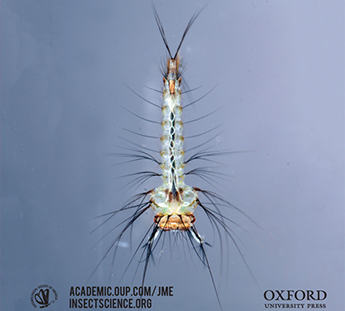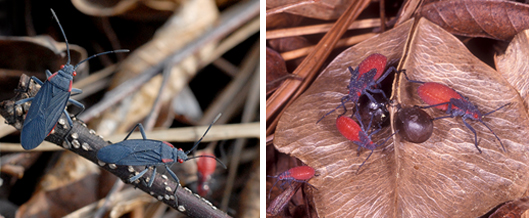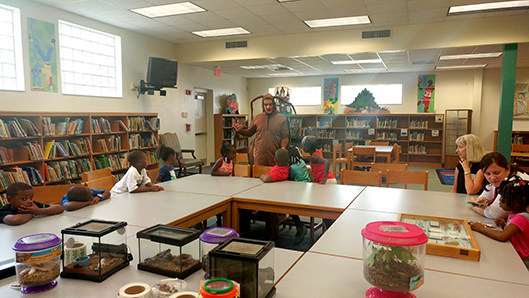- Faculty News
- Student News
- Lab News
- Publications
- Meetings and Presentations
- Outreach
- Grants
- Announcements
- About This Newsletter

ABOVE: Dr. Nathan Burkett-Cadena’s photo is the cover photo for the Journal of Medical Entomology - larva of Aedeomyia squamipennis. See the publications section for the article that appears in this issue (Vol 54, No 3. May 2017).
Dr. James P. Cuda hosted several international visitors in his laboratory during the month of May. Dr. Sean Thackeray, Head of Product Development of Ecoguard, Johannesburg, South Africa, is interested in weed IPM practices, and visited Cuda’s lab on May 15th. Dr. Emilio Gonzalvez, Dr. Julia Parrado, and Dr. Berta Garcia, scientists with the Cuban Plant Health Institute visited Cuda’s lab on May 16th.
 Dr. Barry Alto in the news: The news release highlights a multiplexed kit for the detection of emergent mosquito-borne pathogens Zika, dengue, and chikungunya viruses. The procedure uses loop-mediated isothermal amplification (LAMP) together with innovations in synthetic biology to allow for the detection of these viruses in less than one hour in human and mosquito samples. The first author is Dr. Ozlem Yaren and the senior author is Dr. Steven Benner from Firebird Biomolecular Sciences LLC and the Foundation for Applied Molecular Evolution. Our Dr. Barry Alto was a collaborator on the study.
Dr. Barry Alto in the news: The news release highlights a multiplexed kit for the detection of emergent mosquito-borne pathogens Zika, dengue, and chikungunya viruses. The procedure uses loop-mediated isothermal amplification (LAMP) together with innovations in synthetic biology to allow for the detection of these viruses in less than one hour in human and mosquito samples. The first author is Dr. Ozlem Yaren and the senior author is Dr. Steven Benner from Firebird Biomolecular Sciences LLC and the Foundation for Applied Molecular Evolution. Our Dr. Barry Alto was a collaborator on the study.
Michael Vickers, a Ph.D. student in Dr. Lisa Taylor's lab, was awarded an Animal Behavior Society (ABS) Travel Grant to attend their annual meeting in Toronto, Canada this month. He will be presenting results of an exploratory study that is part of his dissertation research, the talk is entitled: “Alternative Strategies for Dealing with Prey Toxins by Jumping Spiders.” In addition to receiving the ABS award, Michael was also awarded the CALS/IFAS James Davidson Travel Grant to attend the Behaviour 2017 conference in Estoril, Portugal next month. As with the ABS conference, he will be presenting his work on toxin susceptibility and how jumping spiders use different tactics to deal with toxic prey. His talk is entitled, “Alternative strategies for dealing with prey toxins and implications for the evolution of color in jumping spiders.”
 The University of Hawaii Kona Cooperative Extension Service is happy to announce that Mr. Luis Arstizabal has joined the University as a Junior Extension Agent for Coffee Berry Borer. His position entails providing outreach and education to Hawaii's coffee industry and to assist coffee growers with Coffee Berry Borer management.
The University of Hawaii Kona Cooperative Extension Service is happy to announce that Mr. Luis Arstizabal has joined the University as a Junior Extension Agent for Coffee Berry Borer. His position entails providing outreach and education to Hawaii's coffee industry and to assist coffee growers with Coffee Berry Borer management.
Need to name that bug? A host of experts are available to help Floridians identify any insect or related arthropod. If a mystery creature has six or more legs, the UF Insect ID Lab is the place to call.

ABOVE: If you are an entomologist in Florida, it is good to know this bug, because sooner or later someone will probably ask you for its identification. This is Jadera haematoloma, commonly called the jadera bug or red-shouldered bug. They can build up large populations with thousands of bugs crawling over lawns and sidewalks and on the sides of homes. They feed on a variety of plants, but large populations are usually associated with goldenrain trees. The seeds of these trees are a favorite food of jadera bugs. The bugs aren’t harmful to plants, but they can be serious nuisance pests to homeowners. Adults are black above, with red lateral margins on the pronotum. Nymphs have a bright red abdomen and a black thorax and appendages.
Need insect images? You can go to this direct link, pictures are copyrighted material and intended for official UF use only, log onto the website using your Gatorlink credentials.
Lyle Buss is the UF/IFAS Insect ID Lab manager.
 Think it might be a nematode problem? The Nematode Assay Laboratory serves Florida and other states by providing nematode assays and expert advice regarding nematode management.
Think it might be a nematode problem? The Nematode Assay Laboratory serves Florida and other states by providing nematode assays and expert advice regarding nematode management.
For more information on the Nematode Assay Laboratory please contact the lab manager Dr. Tesfa Mengistu.
Adema CM et al. (Bonning BC 19th of 117 authors) 2017. Whole genome analysis of a schistosomiasis-transmitting freshwater snail. Nature Communications8:15451. doi: 10.1038/ncomms15451.
Burkett-Cadena ND, Blosser EM. 2017. Aedeomyia squamipennis (Diptera: Culicidae) in Florida, USA, a new state and country record. Journal of Medical Entomology. 54(3):788-92.
Glushakova LG, Alto BW, Kim MS, Bradley A, Yaren O, Benner SA. 2017. Detection of chikungunya viral RNA in mosquito bodies on cationic (Q) paper based on innovations in synthetic biology. Journal of Virological Methods 246: 104-111.
Huang Y-J, Ayers VB, Lyons AC, Unlu I, Alto BW, Cohnstaedt LW, Higgs S, Vanlandingham DL. 2016. Culex species mosquitoes and Zika virus. Vector-Borne Zoonotic Diseases 16: 673-676.
Liu S, Chen Y, Sappington TW, Bonning BC. 2017. Genome sequence of a small RNA virus, Diabrotica virgifera virgifera virus 2, a novel virus of the western corn rootworm, Diabrotica virgifera virgifera LeConte. Genome Announcements 5(20). pii: e00365-17. doi: 10.1128/genomeA.00365-17.
Liu S, Chen Y, Sappington TW, Bonning BC. 2017. Genome sequence of a novel positive sense, single-stranded RNA virus isolated from western corn rootworm, Diabrotica virgifera virgifera LeConte. Genome Announcements 5(20). pii: e00366-17. doi: 10.1128/genomeA.00366-17.
Martini X, Hughes MC, Killiny N, George J, Lapointe S, Smith JA, Stelinski LL. 2017. The fungus, Raffaelea lauricola, manipulates release of host odors causing behavioral changes to its symbiont and vector, the redbay ambrosia beetle (Xyleborus glabratus). Journal of Chemical Ecology. 43: 519-531.
Penca C, Hodges AC. 2017. Pyriproxyfen treatment terminates Halyomorpha halys reproductive diapause, with an indirect mortality effect on its egg parasitoid Trissolcus japonicus. Journal of Pest Science. doi: 10.1007/s10340-017-0882-8
Seo M, Martini X, Rivera MJ, Stelinski LL. 2017. Flight capacities and diurnal flight patterns of the ambrosia beetles, Xyleborus glabratus and Monarthrum mali. Environmental Entomology. 46: 729-734.
Willett D, Alborn HT, Stelinski LL. 2017. Multitrophic effects of belowground parasitoid learning. Scientific Reports. 7: 2067; doi: 10.1038/s41598-017-02193-2.
Yaren O, Alto BW, Bradley KM, Yang Z, Benner SA. 2017. Point of sampling detection of Zika virus within a multiplexed kit capable of detecting dengue and chikungunya. BMC Infectious Diseases 17: 293. doi:10.1186/s12879-017-2382-0.
 New on Featured Creatures:
New on Featured Creatures:
Fire ant decapitating flies, Pseudacteon spp. Authors Ariane McCorquodale, James P. Cuda, UF Entomology and Nematology Department, Sanford D. Porter, USDA-ARS, Imported Fire Ant and Household Insect Research Unit.
Do you have a favorite creature? Learn how to make it into a Featured Creatures!
The Annual Meeting of the Caribbean Food Crops Society will be held on July 16-22, 2017 in Isla Verde (San Juan Puerto Rico). This will be a joint meeting with the Florida Entomological Society. Registrants for either meeting will be entitled to attend any technical sessions or joint events. Optional field trips are being arranged for July 20 (Guánica Dry Forest through FES) and 21 July (CFCS to be announced). The venue is the Verdanza Hotel ($105/night).
Don’t miss the 100th Annual Meeting of the Florida Entomological Society July 16-20, Isla Verde (San Juan) Puerto Rico
· Joint Meeting with the Caribbean Food Crops Society: http://cfcs.eea.uprm.edu/
Registration with either society entitles you to: Joint opening session, joint socials and poster sessions, access to all technical sessions (See program at http://www.flaentsoc.org/annual.shtml)
- FES registration including Master’s and Ph.D. competition (http://flaentsoc.org/2017registrationform.rtf)
- Student travel grants available!
Venue: Verdanza Hotel: Verdanza Hotel, Isla Verde, Puerto Rico
Two blocks from the best beach in San Juan. Lots of nearby restaurants and places to shop. Deadline for reservations: Thursday, June 15, 2017
Pioneer lecture honoring Dr. Bill Buren of (Solenopis invicta Buren fame) to be given by Dr. Robert Vander Meer at Joint Opening Session of Annual FES and CFCS Meeting in San Juan Puerto Rico.
From the Outreach Coordinator
A big thank you to the students and faculty who volunteered for May’s outreach events!
- May 4th – Duval Early Learning Academy – Michael Gonzalez and Laurel Lietzenmayer
- May 6th – Learning Gate Community School Bioblitz – Lettie Cronin and Laurel Lietzenmayer
- May 11th – Joseph Williams Elementary – Johnalyn Gordon and Dale Halbritter
- May 12th – Star Christian Academy – Michael Gonzalez and Gabby Steele
- May 18th – Idylwild Elementary School Steam Night – Rachel Atchison and Sara Alvarez
- May 20th – Bug Week Bug Zoo – James Brown, Michael Gonzalez, Jose Martinez, Becca Perry, and Johanna Schwartz
Upcoming Events
- June 16th - Ocala Discovery Science Center
- June 26th –Kimball Wiles Elementary – 1:30pm-3:30pm
- June 27th – Baby Gator Child Development and Research Center – 1pm-3pm
- June 28th – Baby Gator Child Development and Research Center – 1pm-3pm
- June 30th – Flagler County Public Library – 9am-12pm
- July 7th – Littlewood Elementary – 1pm-2:30pm
- July 22nd – Zookeeper Day and Santa Fe Zoo – 9am-3pm

ABOVE: Michael Gonzalez (Mr. Roach) presenting to students at Duval Early Learning Academy.
The live critters are always a hit with children and adults alike. The critters are available for you to check out should you be leading an outreach event. We have doubles of our most popular critters, as well as various native insect species depending on the time of year. We have large wood and Plexiglas cages for viewing our native orb weaving spiders. There is one travel cage and one larger static cage. Please be sure to contact us and review the protocol on transporting and handling the critters if you are not already familiar with it. If you lead an outreach, be sure to fill out a documentation form so your event can be included in the newsletter and we can log all outreach events.
If you have any questions, please email me.
Thank you — Laurel Lietzenmayer, Outreach Coordinator.
If you would like to schedule an event or have any outreach questions, go to the Outreach pages on our Bug Club website and contact us. Getting social!
Dr. Brian Bahder, an assistant professor at the Fort Lauderdale Research and Education Center, was awarded a $114,000 grant as a cooperative agreement with the USDA to develop digital PCR assays for the detection of palm-infecting phytoplasmas in plant and insect tissue.
 Dr. James P. Cuda was awarded a $19,393 research grant from the Florida Industrial & Phosphate Research Institute to investigate the suitability of the West Indian gall midge Orseolia javanica (Diptera: Cecidomyiidae) as a potential biological control agent of cogongrass, Imperata cylindrica, a state and federal listed noxious weed.
Dr. James P. Cuda was awarded a $19,393 research grant from the Florida Industrial & Phosphate Research Institute to investigate the suitability of the West Indian gall midge Orseolia javanica (Diptera: Cecidomyiidae) as a potential biological control agent of cogongrass, Imperata cylindrica, a state and federal listed noxious weed.

To all graduate students - If you are interested in presenting a paper at the annual Florida Entomological Society meeting, this year in San Juan, Puerto Rico (July 16-19), there is still time to apply for travel funds (June 23 deadline). You can apply for the travel grants by going to the FES Annual Meeting page and clicking on the Student Awards Announcement link. The paper submission form is on the main FES annual meeting page.
This year the meeting is combined with the Caribbean Food Crops Society annual meeting so is a great opportunity to network with potential future colleagues from the Caribbean. There will also be an optional field trip to the Guanica Biosphere Reserve and State Forest, a unique subtropical dry forest ecosystem.
This is a meeting you won't want to miss so please plan to join us -
Dr. Heather J. McAuslane, FES Student Activities Committee Chair
 FES Honors and Awards 2017
FES Honors and Awards 2017
The Honors and Awards Committee are requesting nominations for 2017 in the following categories:
Entomologist of the year.
Annual Achievement Award for Research.
Annual Achievement Award for Extension.
Annual Achievement Award for Industry.
Annual Achievement Award for Teaching.
Annual Achievement Award for Regulatory Entomology.
Achievement Award for a Collaborative Research Team.
Winners will be announced at the 2017 Annual Meeting. Each nomination should be accompanied with a justification narrative that will be read at the awards luncheon.
Nomination deadline is June 20, 2017.
You can see previous winners at http://www.flaentsoc.org/honors-awards-tributes.html
Nominations should be sent to:
Dr. Jawwad Qureshi
University of Florida, IFAS
Indian River Research and Education Center
Fort Pierce, FL 34945
Ph: 772-577-7339
Fax: 772-468-5668
E-mail: jawwadq@ufl.edu
 Getting social!
Getting social!
We have several social media sites for the Entomology & Nematology Department. To make them easily searchable, all three (YouTube, Facebook and Twitter) have the same page name: UFEntomology. Please share these links with past students or colleagues who may have an interest in departmental activities.
![]() Want to stay up to date? Check out our website home page for a link to our Google calendar.
Want to stay up to date? Check out our website home page for a link to our Google calendar.
Dr. Jennifer Gillett-Kaufman is the newsletter editor and does the HTML coding. Issues usually are published by mid-month. Submit items for an issue by the seventh of that month.
We like to share news when it happens using our social media outlets: Twitter, Facebook and YouTube. Follow us on these sites for daily updates! When you send news, we will post it on one or more of these sites and again in the monthly newsletter. Please be sure you have permission from people in photographs you submit for publication.
UF-Bugnews-L listserv subscribers receive notices when issues are posted. Our home page has instructions for subscribing and unsubscribing.
Special thanks to Haleigh Ray and Nancy Sanders, who reviewed the newsletter for errors, and to Jane Medley and Don Wasik, who built the web page design.
Give Back
Want to support the UF Entomology & Nematology Department? Consider making an online gift today! Questions can be directed to Christy Chiarelli at (352) 392-1975 or ccw@ufl.edu.